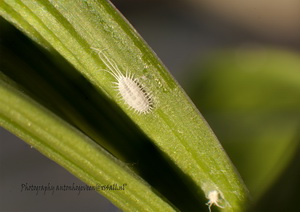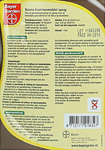
Source: ehow
Mealybugs are cottony-like looking insects with piercing/sucking mouth parts. They suck the fluids from leaves and stems, robbing plants of essential nutrients. Mealybugs feed on all parts of the plant, but especially on tender new growth. Leaves wither and yellow, and on crop plants, fruit may drop prematurely.
To combat the above mentioned lice only systemically acting pesticides are effectively (i.e., the pesticide is absorbed by the plant). The use of these agents (e.g. Temik is widely used) is only permitted for professional growers. For private users, these pesticides are prohibited.
Nowadays there are not many products available for individuals. Previously you could still use pirimiphos-methyl (Actellic) and propoxur (Undeen), but for the small user these are is no longer available.
Bayer brings the following products on the market (who are also effective against aphids shield cap-and mealy bug) imidacloprid (Admire), cyfluthrin (Baytroid plant spray), deltamethrin (Decis) and for pot plants recommended (but maybe also usable in the orchid culture) Provado Plant pin, also based on imidacloprid.
The most useful is Admire. It is a root systematic pesticide, i.e. it is absorbed by the plant roots. You can spray it on the plants (for plants on a block sufficient) but dipping or pouring pots is just as effective if not more effective. The plant spray is only useful on individual plants. For greenhouses is not applicable.
Decis is a broad-acting pesticide also affective against e.g. aphids, thrips, leaf-miners and whiteflies. All these products are for sale at a garden center. The company AA (the products are usually next to Bayer in the displays) delivers similar products.
If it is not too cold outside, a solution seems to be putting out the affected plants for a while. Mealybugs can not withstand cold and do not survive. The eggs, however, can survive even several weeks in the cold. After a few weeks the mealybugs usually will be back again.


A by ourselves well-tried remedy is Bayer Natria Insecticide spray. According to the description, 1 repeated treatment should be sufficient. We however repeated the treatment twice with a 7 day interval. The mealy bug is then guaranteed gone.
This insecticide also work against lice, dop lice and scales.
Always try the least toxic method of pest control as your first step.
Water an infested plant well before releasing mealybug destroyers. These predatory insects will appreciate a drink.
If you use pesticides in your garden, you will kill natural predators of mealybugs.
If you choose a chemical control, always wear protective clothing and safety gear including a long-sleeved shirt, long pants, neoprene gloves, goggles and a respirator.